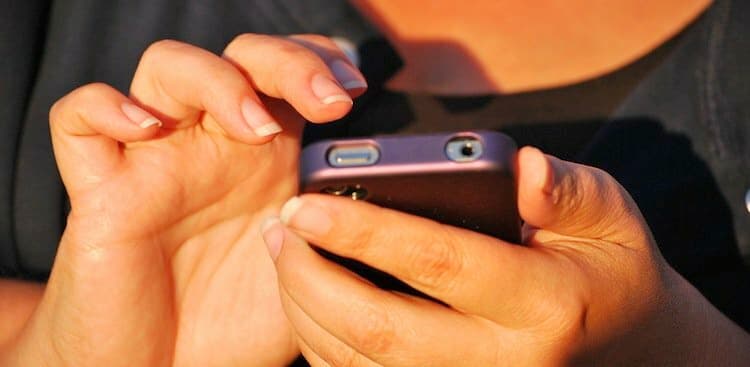It all started innocently enough. Andrea Capdevila (a marketing specialist on maternity leave) was introduced to the addictive charms of the Freefall’n game app by a friend. In no time flat, she found herself complaining of acute thumb pain.
The diagnosis? iPhoneitis. And this wasn’t the first case her doctor had seen.
iPhoneitis is nothing new, according to Dr. Gus Gialamas, MD, a San Clemente, CA, orthopedic surgeon. In the 1980s, it was “Nintendo Thumb” or “Gamers Grip,” and then it morphed into “BlackBerry Thumb.” All are slang terms for the same set of repetitive stress injuries (RSIs) to hands and wrists caused by overuse of electronics. “Your thumbs are not as dexterous as your fingers, and when you’re typing with your thumbs, you tend to type a little harder,” says Gialamas.
And turns out, it’s not just your thumbs—too much smartphone screen time can wreak havoc on your body in other ways, too. Join us for a short tour of cell phone-related maladies and ways to escape their insidious grip.
Electromagnetic Fields & You
Unless you’ve been living stress-free under a rock, you’ve probably picked up mixed messages regarding cancer and cell phones. The concern is that your phone (and microwave and other household appliances) emit non-ionizing radiation that can be absorbed by the tissues closest to where you’re holding the phone (like your brain, if you’re not hands-free).
We’re sorry to say there’s still no clear answer for the estimated 5 billion cell phone subscribers worldwide. Although studies haven’t been able to prove a definitive causal relationship between cancer and cell phones, The World Health Organization/International Agency for Research on Cancer (IARC) classified radiofrequency fields as “potentially carcinogenic to humans” last spring based largely on a study showing some risk for glioma (a rare type of brain cancer) with heavy cell phone use. The IARC did emphasize, however, that further long-term studies are needed to determine a true link between mobile phones and cancer risk.
This doesn’t mean you should rip your Android away from your ear and beeline for the trash, but while follow-up studies are being done, “it is important to take pragmatic measures to reduce exposure such as hands-free devices or texting,” says IARC Director Christopher Wild, in a press release.
Our Advice
Don’t stash your smartphone in your pocket, do remove it from the perch on your pillow, and when you’re chatting, use your headset whenever possible. “In using phones, distance is your friend, because radiation exposure falls off dramatically the farther away from the brain or the body you use your phone,” says Dr. Devra Lee Davis, PhD, MPH, President of the Environmental Trust, in a press release.
Also, when you’re on that snowboarding trip, send an email that you’re definitely out of the office—cell phones emit more radiation when they have weak signals. (We promise your wireless wingman will be just fine without you.)
Walking, Talking, & Texting
You might think you’re the ultimate multi-tasker—but so did the 15-year-old Staten Island girl who fell six feet into an open NYC manhole in 2009 while texting. More than 1,000 pedestrians visited the ER in 2008 because they tripped, fell, or ran into something while talking on their phone. And half of the injured were under 30, according to a study from Ohio State University.
What’s more—researchers suspect many of these injuries go untreated due to embarrassment (running into a telephone pole while texting your cubicle mate the details of last night’s episode of The Bachelor probably isn’t something you want to shout off the rooftops).
A 2009 study of 317 students walking through a central plaza at Western Washington University confirmed that cell phone users walked more slowly, weaved, frequently changed directions, and were less likely to acknowledge other people (and absolutely no alcohol was involved!).
The talkers also suffered from “inattention blindness” (the failure to notice an object plainly in sight because you’re engaged in another activity). Researchers placed a “brightly colored unicycling clown” (yes, you read that correctly) in the same square—and only 25% of cell phone users noticed.
Our Advice
Um, this one is obvious. Sit down somewhere safe (the curb doesn’t count) to continue your conversation. While you’ll probably survive crashing into a brightly colored unicycling clown, there’s no guarantee of the same outcome with a station wagon.
Text Neck
The term “text neck” (coined and trademarked by Florida chiropractor Dean L. Fishman) refers to pain felt after hunching for hours over a handheld. Leaning over any object for an extended period of time (a sink with soapy dishes or a few quality hours of Netflixed Breaking Bad on your handheld) can strain joints, muscles, and soft tissues of the neck, shoulders, and back, causing pain.
And, it’s likely that most of us mad texters are at risk for this modern-day malady. Next time you’re on the train (or on snack break at traffic school if you live in LA) take note—almost everyone with a phone is in a perma-slouch position.
Our Advice
“As more people use iPhones and iPads, they should use the same principles as if they were in an office,” says Gialamas. Basically, if you’re prepping for a marathon texting session after dinner, do it with workplace ergonomics in mind.
Sit in a neutral position, “one that doesn’t put unnecessary stress on the neck, back, shoulders, or hands. This will vary with the individual,” says Gialamas. Try resting your arms on your desk as you work, and remember to take frequent breaks. Switch to a telephone call or your laptop if the texting (or surfing) session starts getting too lengthy.
Gialamas also adds, "Use common sense. Whenever you are doing something repetitively that seems to be causing your neck, back, wrist, or thumbs pain—you stop doing that activity. You rest. That’s the mainstay of treatment. You can also try icing to diminish the inflammatory process and [consider] anti-inflammatory medication… but the gold standard is to rest the affected extremity or injured part. If the pain doesn't improve in a few days, see your physician for an evaluation.”
Most of us see our smartphone as an electronic security blanket, keeping us safe and ever-connected, and feel a little lost when it goes missing between the couch cushions. But remember that there is such as thing as being too connected—especially when a little bundle of glass, electronic circuitry, and plastic has the power to cause undue pain.

